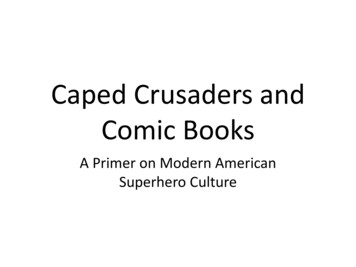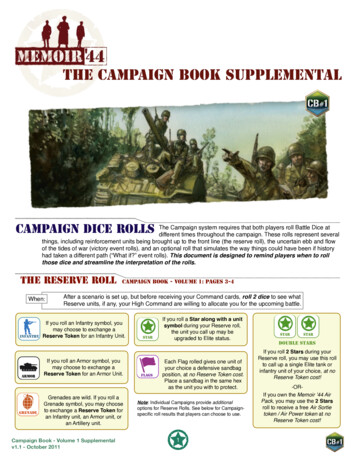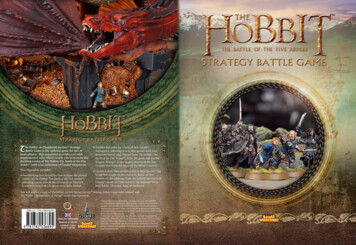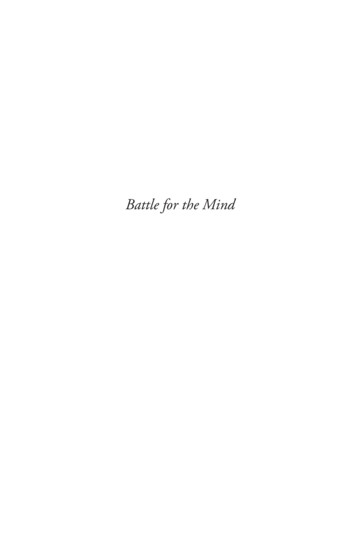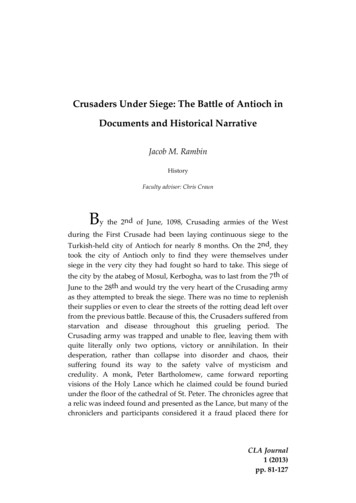
Transcription
Crusaders Under Siege: The Battle of Antioch inDocuments and Historical NarrativeJacob M. RambinHistoryFaculty advisor: Chris CraunBy the 2nd of June, 1098, Crusading armies of the Westduring the First Crusade had been laying continuous siege to theTurkish-held city of Antioch for nearly 8 months. On the 2nd, theytook the city of Antioch only to find they were themselves undersiege in the very city they had fought so hard to take. This siege ofthe city by the atabeg of Mosul, Kerbogha, was to last from the 7th ofJune to the 28th and would try the very heart of the Crusading armyas they attempted to break the siege. There was no time to replenishtheir supplies or even to clear the streets of the rotting dead left overfrom the previous battle. Because of this, the Crusaders suffered fromstarvation and disease throughout this grueling period. TheCrusading army was trapped and unable to flee, leaving them withquite literally only two options, victory or annihilation. In theirdesperation, rather than collapse into disorder and chaos, theirsuffering found its way to the safety valve of mysticism andcredulity. A monk, Peter Bartholomew, came forward reportingvisions of the Holy Lance which he claimed could be found buriedunder the floor of the cathedral of St. Peter. The chronicles agree thata relic was indeed found and presented as the Lance, but many of thechroniclers and participants considered it a fraud placed there forCLA Journal1 (2013)pp. 81-127
82Jacob M. Rambinpolitical gain by one of the Crusade leaders. Chroniclers of the battlereport others claiming holy visions as well, both before and after theLance’s discovery. Regardless of the widespread suspicion ofBartholomew’s character and the doubt held by many of the Crusadeleaders (including the Papal legate, Adhemar) as to the Lance‘sauthenticity, the Crusading army accepted the visions and took upboth the search for the Lance and the celebration of its discoverywith the greatest zeal. Undoubtedly, the boost in morale resultingfrom this played a crucial role in the Crusaders’ victory.The spectacular nature of the Crusaders’ victory as well as thecaptivating episode of the Lance made the Battle of Antioch anintensely popular subject among historians in modern times as wellas contemporary. However, the events surrounding the siege share ahighly politically and religiously charged backdrop of rivalrybetween Crusade leaders, zeal for the Crusade as a divinelysanctioned undertaking, as well as the obvious religiously sensitiveissues surrounding the Holy Lance. Due to this, the chroniclers hadample cause to report these events in different ways from oneanother, and often did. Three chronicles in particular stand out, TheChronicle of Fulcher of Chartres (or the Historia Hierosolymitana), theanonymously-authored Gesta Francorum, and Raymond d’Aguilers’Historia Francorum qui ceperunt Iherusalem. Each of these was writtenby an eye-witness participant, but even more importantly, theseaccounts served as the chief sources for contemporary, noneyewitness chroniclers and historians of the First Crusade. Theseauthors often copied in full the works of these early eye-witnesschroniclers, often with no addition of their own other than to tidy upthe language and style. Furthermore, even other eye-witnessaccounts borrowed extensively from these versions, often onlyadding a few personal remembrances and leaving the restCLA Journal 1 (2013)
Crusaders Under Siege83untouched. Because of this, their traditions of events persist invarious combinations throughout all of historical analysis of the FirstCrusade. Even modern historians remain shackled to the biases andperceptions of these early authors.This naturally creates many problems for historiansattempting to construct historical narratives from these accounts.Modern historians have met this problem by compiling theirnarratives using select details from multiple accounts eachconsidered to be the most authoritative or most probable forindividual episodes during the Crusade. Of course, this is anunavoidable problem associated with document-based histories, andhistorians have little choice but to construct their narratives thusly.However, this is often done without due consideration to theunresolved differences between the accounts. The result has been thecreation of influential modern historiographical traditions, such asthose of Sir Steven Runciman or Kenneth Setton, which are almost aspersistent in the writings of other 20th and 21st century historians asthe early chronicles were upon their contemporaries.This endeavor is not meant as a criticism of admirablehistorians like Runciman or Setton, nor is it a panacea for the issue ofwriting document-based narratives of the First Crusade; it ishowever meant as an indication of where historical analysiscurrently stands on these documents and as an entreaty for mindfulinterpretation and use of these vital, loaded, and often overlyinfluential chronicles. While most traditional historians haveconstructed their narratives by scavenging details from multipleaccounts of the First Crusade, the controversy over the events at theBattle of Antioch and the finding of the Holy Lance illustrate that thisapproach often ignores the complexity of the issue and using onlyCLA Journal 1 (2013)
84Jacob M. Rambinone historian’s narrative can prove as much a problem forestablishing a balanced perspective as relying on a sole primarysource chronicle.The Chronicles and ChroniclersThe level of disparity between accounts of the First Crusadecreates obvious challenges for constructing precise narrative historiesbased on their analysis. An understanding of the biases andcharacters of the authors behind these accounts is central to anyargument dealing with this problem. Therefore the purpose of thissection will be to provide that much needed introduction as well asto highlight and anticipate some of the key claims about theseaccounts and their authors which will be revisited later.Many general factors of the age and circumstancescontributed to the ways in which these accounts were written. Tostart, the accounts are limited by the very feature which gives themtheir unique value. In John France’s words, “Overall, the centralproblem of these eye-witness sources is that they were eye-witnesseswith all the narrowness of perspective that implies.” 1 No writercould be present at every battle, observe every skirmish, or be privyto every political decision made by the Crusade’s leaders. Thechroniclers reported according to what they knew and wherefamiliar with and each come with their own strengths andweaknesses which will be elucidated upon later.2 Ecclesiasticalwriting in the European Middle Ages from the 7th to the 11thJohn France, Victory in the East: A Military History of the First Crusade (Cambridge:Cambridge University Press, 1994), pg. 3772 Ibid. Military history lends itself particularly well to the analysis of howchroniclers reported events in terms of what they knew or were familiar with.1CLA Journal 1 (2013)
Crusaders Under Siege85Centuries essentially held sway. The cleric became almost the solewritten voice for that age. According to August C. Krey, the typicalthemes for writers of this period were; “theological writings,Scripture, the writings of Church Fathers, books of Church service,textbooks for the schools, and treatises on kindred subjects ” 3 Thechronicles of the First Crusade are largely responsible for bringingthis to an end with a wealth of information on the secular activities ofnearly every social class from nearly all regions of Europe. Theperception that the accomplishments of the Crusade leaders andparticipants were to be lauded as a new “chapter to Sacred History” 4drew intimate attention to the individual deeds of previouslyignored segments of the population.5 Certainly, then, it is not anexaggeration to claim that religion and genuine belief in the divinesignificance of the Crusade were a motivator for eyewitnesses tochronicle the event. However, its usefulness is limited as anexplanatory factor for discrepancies between these accounts. For one,The Gesta Francorum, Raymond d’Aguilers’ account, and that ofFulcher of Chartres, are simply composed so early as to preclude theemployment of high-level refinement or interpolations anticipatoryof future Crusading movements on any grand scale.6 These threeAugust Krey, The First Crusade: The Accounts of Eye-Witnesses and Participants(Princeton: Princeton University Press, 1921), pg. 44 Ibid, pg. 6 But for a more detailed study of this perception in the minds ofCrusaders and Crusade chroniclers, see Jonathan Riley-Smith, The First Crusade andthe Idea of Crusading (Philadelphia: University of Pennsylvania Press, 1986)5 See August Krey, The First Crusade: The Accounts of Eye-Witnesses and Participants(Princeton: Princeton University Press, 1921), pgs.2-13 Steven Runciman, A Historyof the Crusades, Volume I: The First Crusade and the Foundations of the Kingdom ofJerusalem (Cambridge: Cambridge University Press, 1951), pgs. 327-3306 See August Krey, The First Crusade: The Accounts of Eye-Witnesses and Participants(Princeton: Princeton University Press, 1921), pgs.2-13, Jonathan Riley Smith, TheFirst Crusade and the Idea of Crusading (Philadelphia: University of Pennsylvania3CLA Journal 1 (2013)
86Jacob M. Rambinsources in particular were chosen for this topic because they serve asthe greatest sources of information used by authors of later, morerefined accounts, often appearing copied almost in full. The religioussignificance of the Crusade as motivating factor for the chroniclersserves much better instead as an indicator of what was mostimportant to the authors to record and of their level of credulity withregards to the mystical or supernatural.7Many other personal biases come into play such as politicalloyalties, attitudes toward Byzantines, Orthodox Christians andTurks. But each of these simply form the author’s perspective—whatwas important to him and what wasn’t, what he knew and didn’tknow, who he was partial to and who he held in contempt. They donot add up to an artfully constructed, thoroughly pre-meditatedpolitical or religious agenda. In fact, much of the work put intorevised accounts based on these was to make up for the “absence of apolished literary finish.”8 For example, the most popular account,The Gesta Francorum, inspired three early revisionist accounts basedupon it, those of Baldric of Dol, Guibert of Nogent and Robert theMonk.9 Each of these authors complained of the Gesta’s base,Press), pgs. 135-152. Riley-Smith’s work is an authority on what he refers to as“theological refinement” present in the chronicles, he locates this trend most withlater chroniclers such as Baldric of Dol, Guibert of Nogent and Robert the Monk.7 This will become especially important during the episode of the Holy Lance. SeeAugust Krey, The First Crusade: The Accounts of Eye-Witnesses and Participants(Princeton: Princeton University Press, 1921) and Steven Runciman, A History of theCrusades, Volume I: The First Crusade and the Foundations of the Kingdom of Jerusalem(Cambridge: Cambridge University Press, 1951)8 Ibid, pg. 49 Robert the Monk’s chronicle has, however, received more attention relativelyrecently as possibly being less dependent on the Gesta than previously assumed.CLA Journal 1 (2013)
Crusaders Under Siege87uneducated language, lack of refined structure and artless style.10Obviously, this helps to overcome some of the challenges associatedwith constructing narrative histories from these three accounts inparticular. The details presented within these earliest accounts arereported based on what was most immediately important to theauthor to record, call attention to or imply. Regardless of whetherimmediate importance is given to details such as the deeds ofCrusade leaders to whom they owe loyalty, to mystical visions andsacred relics, or to soldiers’ camp stories, speculations andexaggerations, much can be learned from deconstructing theseperspectives and the effects they have upon their author’s accounts.However, deconstruction of these perspectives naturally bringsabout deconstruction of the assumptions made by narrative historiesconstructed from multiple, often conflicting accounts.The Gesta FrancorumThe first of these early accounts is the Gesta Francorum etAliorum Hierosolimitorum, or simply the Gesta Francorum. Written byan anonymous author, this account became the most popular andwas often borrowed from or copied entirely by later chroniclers. Itappeared earlier than the others and was probably written on theSee Carol Sweetenham trans., Robert the Monk’s History of the First Crusade: HistoriaHierosolymitana (Aldershot: Ashgate, 2005)10 See Jonathan Riley Smith, The First Crusade and the Idea of Crusading(Philadelphia: University of Pennsylvania Press), pgs. 135-139 Peter Tudebode’saccount and the Historia Belli Sacri are two other works which are essentially copiesof the Gesta. See John France, Victory in the East: A Military History of the FirstCrusade (Cambridge: Cambridge University Press, 1994), pg.379. For moreinformation on the relationship between the Gesta and Tudebode’s account, seeConor Kostick, The Social Structure of the First Crusade (Leiden, The Netherlands:Brill Publishing, 2008), pgs. 20-27CLA Journal 1 (2013)
88Jacob M. Rambinjourney. Ekkehard of Aura had a copy available to him in Jerusalemin 1101, suggesting it was probably published in 1100 or earlier thatyear.11 The account’s uncertain authorship makes this a challengingchronicle to analyze and its discrepancies difficult to account for.Thankfully, historians are not to be foiled by his anonymity andmuch research has become available on this mysterious figure oftenreferred to by classic histories of the Crusades as simply TheAnonymous.12 Additionally, much can be inferred from the author’swriting with regards to his origins and biases. For instance, his use ofLatin has led some historians to place him as being from NormanSouthern Italy.13 This fits with another feature of this account, theauthor’s reverence toward the Italo-Norman Crusade leaderBohemond of Taranto. Throughout the account, while otherchronicles seem to consider Bohemond’s actions to be rash and selfserving, the Gesta endeavors to defend and glorify him. Takentogether these two points indicate a strong Norman bias. TheAnonymous’ writing betrays a lack of education, it is strained andhis use of adjectives severely limited.14 As discussed above, the chiefcriticism of this account by its contemporaries was its base languageand “uncouth style.”15See Steven Runciman, A History of the Crusades, Volume I: The First Crusade and theFoundations of the Kingdom of Jerusalem (Cambridge: Cambridge University Press,1951) pgs. 329-33012 For a more in depth look at the author of the Gesta Francorum, see JayRubenstein, “What is the Gesta Francorum and Who is Peter Tudebode,” RevueMabillon 16 (2005) pgs. 179-20413 August Krey, The First Crusade: The Accounts of Eye-Witnesses and Participants(Princeton: Princeton University Press, 1921), pg. 714 Ibid, pg. 715 See the section “Theological Refinement” in Jonathan Riley Smith, The FirstCrusade and the Idea of Crusading (Philadelphia: University of Pennsylvania Press)pgs. 135-13911CLA Journal 1 (2013)
Crusaders Under Siege89Furthermore, the author of the Gesta takes a much moresecular point of view compared to the other accounts and seems tohave participated in combat, leading many historians (in conjunctionwith his apparently poor education and writing) to conclude that hewas not, in fact, a cleric. This would make him unique among theother chroniclers. He must have been a lesser knight, given his “lackof intimacy with the leaders ”16 The fact that he left his lord’sservice after Antioch and continued on to Jerusalem speaks to bothhis character as a soldier and a believer. His account also stands outfor its general impartiality toward the other Crusade leaders as wellas toward the Turks. The Anonymous is also limited by the “worm’seye-view” problem described by France.17 A simple soldier, TheAnonymous as an eye-witness often proves unable to graduate fromthis point of view and fails to place his revelations and observationsin the appropriate grand context. According to Krey, “What he lackselsewhere is greatly outweighed by his judgment in evaluating therelative importance of events, his restraint in preventing intimatedetails from obscuring the perspective of his story, his unusualfairness and impartiality toward the rival Christian leaders, as wellas his Turkish foes, and a certain native instinct for the dramaticapparent throughout the book.”18That said, even its oldest extant copy contains evidence oflater meddling. Sir Steven Runciman identifies both a passage takenAugust Krey, The First Crusade: The Accounts of Eye-Witnesses and Participants(Princeton: Princeton University Press, 1921), pg. 717 For an insightful take on the Anonymous’ apparent perspective in the Gesta, seeJohn France, Victory in the East: A Military History of the First Crusade (Cambridge:Cambridge University Press, 1994), pgs. 377-37918 August Krey, The First Crusade: The Accounts of Eye-Witnesses and Participants(Princeton: Princeton University Press, 1921), pg. 716CLA Journal 1 (2013)
90Jacob M. Rambinfrom Raymond d’Aguilers and one which corrupts the record ofBohemond’s dealings in Constantinople as having been added byothers.19 Additionally, some other historians claim the story ofKerbogha’s mother is another such interpolation.20 John France inVictory in the East stresses the importance of these passages and otherinstances of possible revision, writing that “ there are indicationsthat what we have may not be the text written or dictated by ananonymous South Italian Norman knight in the service ofBohemond. He goes on to suggest that several literary passages showsigns of later revision or even entirely different authorship. 21 Thismay be due in part to Bohemond’s vital role in the account’spopularity, for regardless of any pro-Norman slant to this account’swriting, its distribution was certainly a political affair. In 1106,Bohemond personally propagated it throughout Northern Franceand according to Runciman, considered it his apologia.22 The Gesta’sinflated popularity and obvious influence over nearly every otheraccount of the First Crusade lead France to claim that “ de facto theidea has grown that the Anonymous’ is the ‘normal’ account of thecrusade and its frame work has been built into almost all modernSee Steven Runciman, A History of the Crusades, Volume I: The First Crusade and theFoundations of the Kingdom of Jerusalem (Cambridge: Cambridge University Press,1951) pgs. 159, 32920 See Natasha Hodgson, Women, Crusading and the Holy Land in Historical Narrative(New York: Boydell Press, 2007) pgs. 190-19621 See John France, Victory in the East: A Military History of the First Crusade(Cambridge: Cambridge University Press, 1994), pgs. 377-37822 Steven Runciman, A History of the Crusades, Volume I: The First Crusade and theFoundations of the Kingdom of Jerusalem (Cambridge: Cambridge University Press,1951) pgs. 329-33019CLA Journal 1 (2013)
Crusaders Under Siege91writing”23 and then to warn that this its appearance as the traditionalaccount of the First Crusade is “ a dangerous illusion.”24The Account of Raymond d’AguilersThe next significant account to be analyzed is that ofRaymond d’Aguilers, known as the Historia Francorum qui ceperuntIherusalem. Much more can be said specifically about Raymond’sorigins and motivations for writing his account. He probably beganwriting his account on the Crusade, during the siege of Antioch. Hiswork appears after the Gesta but was published before 1105, the yearof Count Raymond of St. Gilles’ death, of which this account makesno mention.25 This account was originally to be co-written with onePontius of Balazun, a Provencal knight who died at Archas.26 Thougha cleric, he shows a remarkable lack of clerical restraint when itcomes to his credulous belief in and ready acceptance of divineintervention and the mystical more generally. This may be due inpart to the fact that he was only elevated to the priesthood after theCrusade began. He came to serve as chaplain to Count Raymond ofSt. Gilles and is particularly valuable given his intimate familiaritywith that crusade leader and other Frankish princes, as well as withAdhemar, the Bishop of Puy and papal legate to the Crusadingarmy.27 This close relationship with the leadership of the CrusadingSee John France, Victory in the East: A Military History of the First Crusade(Cambridge: Cambridge University Press, 1994), pgs. 378-37924 Ibid, pg. 37925 Ibid, pg. 37726 August Krey, The First Crusade: The Accounts of Eye-Witnesses and Participants(Princeton: Princeton University Press, 1921), pg. 827 See Edward Peters, The First Crusade: The Chronicle of Fulcher of Chartres and OtherSource Materials (Philadelphia: University of Pennsylvania Press, 1971), and August23CLA Journal 1 (2013)
92Jacob M. Rambinarmy allows Raymond’s account to place events in better context andto provide much needed information on the political affairs of theleaders and the army’s “internal dynamics.”28 This serves as a greatrelief to the dearth of such context in the Gesta but the accountultimately proves unable to provide as much detail on militaryengagements. August Krey claims that Raymond’s is the mostvaluable of all the accounts for “sociological aspects of theCrusade.”29Despite this, Raymond d’Aguilers’ account is often criticizedas highly partisan and “a mass of confused and credulousmysticism.”30 His chief motivations for writing his account seem tobe a desire to impart the tale of Count Raymond, the Provencal armyand Adhemar of le Puy as well as to call out and defend the divinesignificance of the Crusade31, the Antiochene Holy Lance inparticular.32 Though d’Aguilers certainly was not uncritical of CountRaymond or of the Provencal host and at times proves able to setaside his bias, the man did seem to harbor an unabiding hatred forKrey, The First Crusade: The Accounts of Eye-Witnesses and Participants (Princeton:Princeton University Press, 1921), pgs. 8-928 See John France, Victory in the East: A Military History of the First Crusade(Cambridge: Cambridge University Press, 1994), pgs. 376-37729 August Krey, The First Crusade: The Accounts of Eye-Witnesses and Participants(Princeton: Princeton University Press, 1921), pg. 930 Ibid, pg. 831 See Marcus Bull, Knightly Piety and the Lay Response to the First Crusade (NewYork: Oxford University Press, 1993) pgs. 242-24632 Ibid, pgs. 7-9, John France, Victory in the East: A Military History of the FirstCrusade (Cambridge: Cambridge University Press, 1994), pgs. 375-377, StevenRunciman, A History of the Crusades, Volume I: The First Crusade and the Foundationsof the Kingdom of Jerusalem (Cambridge: Cambridge University Press, 1951) pgs.328-329CLA Journal 1 (2013)
Crusaders Under Siege93Greeks and all their ways.33 He openly disapproved of CountRaymond’s cooperative attitude toward the Byzantines andthroughout his entire account, only mentions them once without ascornful remark.34 His presentation of Antioch’s siege borrows fromthe Gesta, but only to make up for his own focus on the episode of theLance. Otherwise, his account his almost entirely independent.35 Hisreporting of the events at Antioch after Kerbogha’s siege began isessentially devoted to the Lance and the visions reported byBartholomew and others in the city. He appears utterly unwilling toacknowledge that the Crusader’s suffering and sense of eminentdoom had anything to do with their desperate belief in divineintervention and credulity toward unshackled mysticism. Instead,like Fulcher of Chartres’ account later, he paints their hardships atAntioch as punishment for their sins committed on the Crusade andwhen taking the city. France suggests that Raymond’s true purposehere is to “show the workings of the divine economy as thenunderstood.”36 He was among the staunchest defenders of the visionsRunciman discusses Raymond’s instances of being critical of the Count ofToulouse and hatred of Greeks. France also describes his anti-Greek sentiments.See Steven Runciman, A History of the Crusades, Volume I: The First Crusade and theFoundations of the Kingdom of Jerusalem (Cambridge: Cambridge University Press,1951) pg. 328 and John France, Victory in the East: A Military History of the FirstCrusade (Cambridge: Cambridge University Press, 1994), pg. 37534 See Steven Runciman, A History of the Crusades, Volume I: The First Crusade and theFoundations of the Kingdom of Jerusalem (Cambridge: Cambridge University Press,1951), pg. 32835 France discusses the addition of details from the Gesta. See John France, Victoryin the East: A Military History of the First Crusade (Cambridge: Cambridge UniversityPress, 1994), pg. 377 See also Susan Edgington, “The First Crusade: Reviewing theEvidence” in The First Crusade: Origins and Impact, ed. Jonathan Phillips,(Manchester, UK: Manchester University Press, 1997), pg. 5636 France, referring to the divine cycle perceived by d’Aguilers, that sin leads tofalling out of favor with the divine, and in turn punishment. In this case, the33CLA Journal 1 (2013)
94Jacob M. Rambinof Peter Bartholomew, the barely-literate pilgrim who claimed St.Andrew revealed the Lance’s location to him, and even participatedin its excavation. Interestingly, even after Bartholomew died fromsevere burns received during an Ordeal by Fire to prove the validityof his visions, d’Aguilers’ credulity persisted. The zealous andclumsy defense of Bartholomew’s visions and the episode of theLance at Antioch that has caused many historians to diminish hisaccount’s value may indeed be due to Raymond’s conscious desire toamend popular opinion in light of Bartholomew’s denunciation, asKrey suggests.37 These strong biases and motivations maked’Aguilers account particularly problematic, but its other strengthsensures its lasting value to historians.The Chronicle of Fulcher of ChartresFinally, the third major account to be analyzed is theChronicle of Fulcher of Chartres, the Historia Hierosolymitana. Fulcherwas a Frankish cleric present at the Council of Clermont in 1095,where Urban II preached the Crusade. By this time, Fulcher hadreceived his clerical training and was a priest in either Chartres orOrleans.38 Fulcher joined the Crusade when Stephen of Blois’ armypassed through Chartres. He left Europe attached to the armies ofStephen, Robert of Normandy and Robert of Flanders. However,Crusaders falling woefully under siege in Antioch. Endurance of punishment andthe restoration of piety returns God’s favor whom, to d’Aguilers, is responsible fortheir spectacular victory over Kerbogha’s army. See Ibid, pgs. 375-37637 August Krey, The First Crusade: The Accounts of Eye-Witnesses and Participants(Princeton: Princeton University Press, 1921), pgs. 8-938 See Ibid, pg. 9 and Edward Peters, The First Crusade: The Chronicle of Fulcher ofChartres and Other Source Materials (Philadelphia: University of Pennsylvania Press,1971), pg. 47and August Krey, The First Crusade: The Accounts of Eye-Witnesses andParticipants (Princeton: Princeton University Press, 1921), pg. 47CLA Journal 1 (2013)
Crusaders Under Siege95when Godfrey of Bouillon’s younger brother, Baldwin, detachedfrom the other Crusaders to secure Edessa for himself, he joinedBaldwin and served loyally as chaplain. He remained with Baldwinuntil the Fall of Jerusalem in 1099, at which point he made apilgrimage there with Bohemond and Baldwin, but ultimatelyreturned to Edessa with his lord. When Baldwin became King ofJerusalem, he returned and remained in Baldwin’s service until hisdeath in 1118. Edward Peters suggests he may then have becomeprior of the Mount of Olives.39 He probably began writing hischronicle in 1101 with the first part appearing as early as 1105, butwas not completed until 1127-1128.40Fulcher’s account stands out sharply against the others heredue to the fact that his service to Baldwin kept him from actuallybeing present at the Siege of Antioch. However, Fulcher gatheredgood information and his account is valuable for this battleparticularly as a counterweight to the others. Both d’Aguilers’account and the Gesta are highly charged with their own biases.While Fulcher’s certainly shows some of the same motivating factorsas d’Aguilers’, namely a conscious effort to call out the religioussignificance of the Crusade, he remains the most non-partisan of thethree and seems to have earnestly reported his understanding ofevents. He was also probably the most well educated of theChroniclers, as evidenced by his writing.41 Further, his has beenSee Edward Peters, The First Crusade: The Chronicle of Fulcher of Chartres and OtherSource Materials (Philadelphia: University of Pennsylvania Press, 1971), pg. 47 andthe more recent Christopher Tyerman, The Chronicles of the First Crusade (NewYork: Penguin Group, 2012)40 Ibid, pg. 4741 See Steven Runciman, A History of the Crusades, Volume I: The First Crusade and theFoundations of the Kingdom of Jerusalem (Cambridge: Cambridge University Press,39CLA Journal 1 (2013)
96Jacob M. Rambinwidely considered by historians to be the most reliable of theaccounts. As Peters puts it, “Fulcher’s presence throughout most ofthe expedition, his close connection with the princes of northernFrance and later with Baldwin, and his ability to organize a maze ofcomplex experiences and motives, make his chronicle perhaps themost reliable of all sources for the history of the First Crusade.” 42Fulcher wasn’t particularly interested in the politics of the Crusadeleaders but certainly shows evidence of some influence of theirintrigues on his writing. France argues, for instance, that Fulcher’sfailure to cover the issues that split the
Crusaders Under Siege: The Battle of Antioch in Documents and Historical Narrative Jacob M. Rambin History Faculty advisor: Chris Craun B y the 2nd of June, 1098, Crusading armies of the West during the First Crusade had been laying continuous siege to the Turkish-held city of Antioch for nearly 8 months. On the 2nd, they



